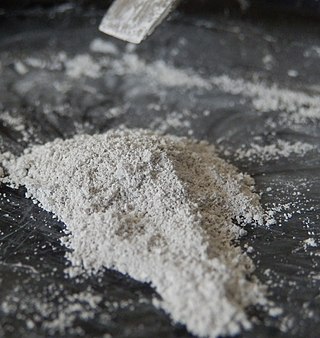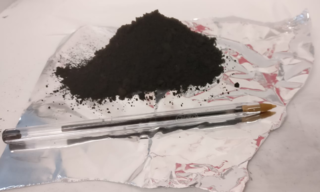
In crystallography, the cubiccrystal system is a crystal system where the unit cell is in the shape of a cube. This is one of the most common and simplest shapes found in crystals and minerals.

Thiocyanates are salts containing the thiocyanate anion [SCN]−. [SCN]− is the conjugate base of thiocyanic acid. Common salts include the colourless salts potassium thiocyanate and sodium thiocyanate. Mercury(II) thiocyanate was formerly used in pyrotechnics.

The cyanate ion is an anion with the chemical formula OCN−. It is a resonance of three forms: [O−−C≡N] (61%) ↔ [O=C=N−] (30%) ↔ [O+≡C−N2−] (4%).
The coordination geometry of an atom is the geometrical pattern defined by the atoms around the central atom. The term is commonly applied in the field of inorganic chemistry, where diverse structures are observed. The coordination geometry depends on the number, not the type, of ligands bonded to the metal centre as well as their locations. The number of atoms bonded is the coordination number. The geometrical pattern can be described as a polyhedron where the vertices of the polyhedron are the centres of the coordinating atoms in the ligands.
A solubility chart is a chart describing whether the ionic compounds formed from different combinations of cations and anions dissolve in or precipitate from solution.

Mercury(II) thiocyanate is an inorganic chemical compound, the coordination complex of Hg2+ and the thiocyanate anion. It is a white powder. It will produce a large, winding "snake" when ignited, an effect known as the Pharaoh's serpent.
In chemistry, crystallography, and materials science, the coordination number, also called ligancy, of a central atom in a molecule or crystal is the number of atoms, molecules or ions bonded to it. The ion/molecule/atom surrounding the central ion/molecule/atom is called a ligand. This number is determined somewhat differently for molecules than for crystals.

Thiocyanogen, (SCN)2, is a pseudohalogen derived from the pseudohalide thiocyanate, [SCN]−, with behavior intermediate between dibromine and diiodine. This hexatomic compound exhibits C2 point group symmetry and has the connectivity NCS-SCN.

Cobalt(II) thiocyanate is an inorganic compound with the formula Co(SCN)2. The anhydrous compound is a coordination polymer with a layered structure. The trihydrate, Co(SCN)2(H2O)3, is a isothiocyanate complex used in the cobalt thiocyanate test (or Scott test) for detecting cocaine. The test has been responsible for widespread false positives and false convictions.
Lead(II) thiocyanate is a compound, more precisely a salt, with the formula Pb(SCN)2. It is a white crystalline solid, but will turn yellow upon exposure to light. It is slightly soluble in water and can be converted to a basic salt (Pb(CNS)2·Pb(OH)2 when boiled. Salt crystals may form upon cooling. Lead thiocyanate can cause lead poisoning if ingested and can adversely react with many substances. It has use in small explosives, matches, and dyeing.

Silver thiocyanate is the silver salt of thiocyanic acid with the formula AgSCN. Silver thiocyanate appears as a white crystalline powder. It is very commonly used in the synthesis of silver nanoparticles. Additionally, studies have found silver nanoparticles to be present in saliva present during the entire digestive process of silver nitrate. Silver thiocyanate is slightly soluble in water, with a solubility of 1.68 x 10−4 g/L. It is insoluble in ethanol, acetone, and acid.

Copper(I) thiocyanate is a coordination polymer with formula CuSCN. It is an air-stable, white solid used as a precursor for the preparation of other thiocyanate salts.
Barium thiocyanate refers to salts of the formula Ba(SCN)2.xH2O. Both an anhydrous salt and a trihydrate are known. The anhydrous salt is hygroscopic. The trihydrate is soluble in most alcohols but insoluble in simple alkanes. Barium thiocyanate is used in dyeing textiles and in some photographic solutions. But because of its toxicity, it has limited uses.

Copper(II) thiocyanate (or cupric thiocyanate) is a coordination polymer with formula Cu(SCN)2. It is a black solid which slowly decomposes in moist air. It was first reported in 1838 by Karl Ernst Claus and its structure was determined first in 2018.
The nitridosilicates are chemical compounds that have anions with nitrogen bound to silicon. Counter cations that balance the electric charge are mostly electropositive metals from the alkali metals, alkaline earths or rare earth elements. Silicon and nitrogen have similar electronegativities, so the bond between them is covalent. Nitrogen atoms are arranged around a silicon atom in a tetrahedral arrangement.
Sulfidostannates, or thiostannates are chemical compounds containing anions composed of tin linked with sulfur. They can be considered as stannates with sulfur substituting for oxygen. Related compounds include the thiosilicates, and thiogermanates, and by varying the chalcogen: selenostannates, and tellurostannates. Oxothiostannates have oxygen in addition to sulfur. Thiostannates can be classed as chalcogenidometalates, thiometallates, chalcogenidotetrelates, thiotetrelates, and chalcogenidostannates. Tin is almost always in the +4 oxidation state in thiostannates, although a couple of mixed sulfides in the +2 state are known,
A tellurite tellurate is chemical compound or salt that contains tellurite and tellurate anions [TeO3]2- [TeO4 ]2-. These are mixed anion compounds, meaning the compounds are cations that contain one or more anions. Some have third anions. Environmentally, tellurite [TeO3]2- is the more abundant anion due to tellurate's [TeO4 ]2- low solubility limiting its concentration in biospheric waters. Another way to refer to the anions is tellurium's oxyanions, which happen to be relatively stable.
Lithium thiocyanate is a chemical compound with the formula LiSCN. It is an extremely hygroscopic white solid that forms the monohydrate and the dihydrate. It is the least stable of the alkali metal thiocyanates due to the large electrostatic deforming field of the lithium cation.
Transition metal complexes of thiocyanate describes coordination complexes containing one or more thiocyanate (SCN-) ligands. The topic also includes transition metal complexes of isothiocyanate. These complexes have few applications but played significant role in the development of coordination chemistry.
Calcium thiocyanate refers to the salt Cs(SCN)2. It is a colorless solid. According to X-ray crystallography, it is a coordination polymer. The Ca2+ ions are each bonded to eight thiocyanate anions, with four Ca-S and four Ca-N bonds. The motif is reminiscent of the fluorite structure.









